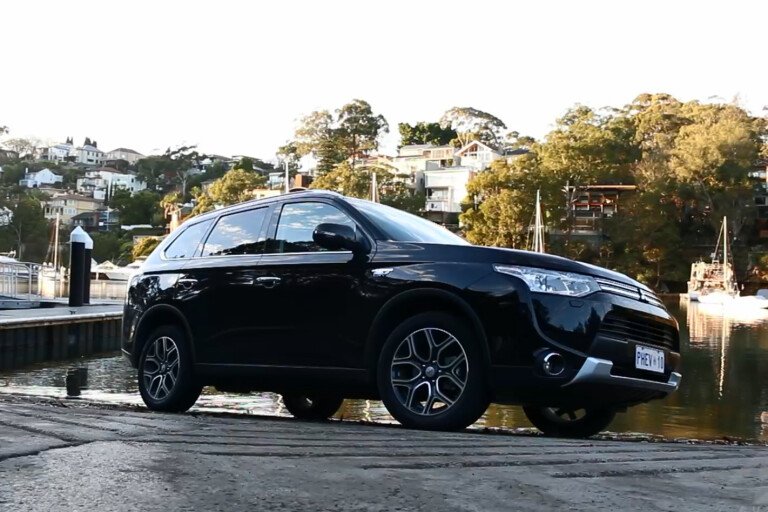
Mitsubishi Outlander Off-Road Review
Price and specifications
- Price: $47,490
- Engine: 2.0-litre 4-cylinder, 87kW at 4500rpm, 186Nm at 4500rpm
- Electric motors: 60kW/137Nm (front wheels), 65kW/195Nm (rear wheels)
- Transmission and 4WD system: High range CVT, constant four-wheel-drive
- Braked tow capacity: 1500kg
- Spare tyre: None; tyre repair kit
- Fuel tank: 45 litres
- Fuel use (claimed): 1.9L/100km
- Fuel use on test: Between 0L/100km (on electricity around town) and 11.2L/100km (country driving)
- Approach/departure angles: 21.5 degrees/22.5 degrees
- Ground clearance: 190mm
WHAT’S THE DEAL?
PHEV stands for plug-in hybrid electric vehicle. The Outlander PHEV uses the Outlander’s mid-sized SUV body but uses a smaller 2.0-litre engine and twin electric motors. It can drive purely on electricity for about 35-40km and be recharged in five hours. However, you’ll need a 15-amp powerpoint, which has a longer earth pin and won’t fit in most regular powerpoints.
The PHEV can also run purely on petrol, with the specially tuned engine acting as a generator for the battery cells, which sit beneath the floor. The engine also directly drives the wheels through a CVT transmission for additional power.
All that complexity doesn’t come cheaply, though, with the base PHEV priced at $47,490 (plus on-road and dealer costs). That’s $11,000 more than the equivalently specified petrol Outlander, and $8000 more than the diesel.
The better equipped Aspire we tested is $52,490 and brings things such as leather seats, electric front seats, sunroof, radar cruise control and a colour touchscreen with satellite-navigation.
![IMG_0333[1]](https://assets.whichcar.com.au/image/upload/s--efkDHgCu--/c_fill,f_auto,q_auto:good/c_scale,w_768/v1/archive/motor-media/1085155/img_0333-1-_500x333.jpg )
PRACTICALITY
Other than the odd badges denoting it’s a PHEV it looks and smells like any other Outlander. But because of the additional hardware (and software) lying beneath the third row of seats are not there, limiting capacity to five people. Still, there’s respectable head and leg room for all, although three wider bums across the rear could get squeezy.
The load space is also useful, although the underfloor storage compartment has been taken up by the chunky charging cable. Some badly done faux metal strips inside do nothing for the ambience, which is lifted by the leather trim and central screen. But that central screen has some frustrating menus and small buttons that make selecting things more difficult than they should be.
ON THE ROAD
At 1810kg the PHEV is 280kg heavier than other models and it feels it on the road. There’s some sloppiness to its cornering manners and it can lumber into bumps. But its independent suspension front and rear deliver reasonable control and make it easy to manoeuvre around town.
There’s some tyre roar at higher speeds but the cabin is otherwise hushed enough to make it a comfortable long distance cruiser. Speaking of which, the petrol engine and 45-litre fuel tanks means you can cover up to about 500km in regular driving.
Don’t get excited by the claimed fuel use of 1.9 litres per 100km. It’s unachievable unless you’re going to drive it gently for 30 or 40km between charges. If you do it’s effortless enough, only relying on the engine up bigger hills or when you press the accelerator further down. Plus you have to factor in higher electricity bills; it’s about $3.50 for a charge.
On the open road the PHEV is less convincing, mainly because you’re carrying around so much extra weight, which takes its toll on fuel use. It’s not difficult to use more than 10L/100km, which is worse than most diesels of similar performance.
![IMG_0342[1]](https://assets.whichcar.com.au/image/upload/s--3rnJ4lJO--/c_fill,f_auto,q_auto:good/c_scale,w_768/v1/archive/motor-media/1085160/img_0342-1-_500x333.jpg )
OFF-ROAD
Mitsubishi makes no secret of the fact the PHEV is more soft-roader than off-roader. The owner’s manual says it has been designed to “occasionally travel on unpaved roads, to campgrounds, picnic sites and similar locations”. It also warns against driving on “steep slopes” and on a “flooded road”, which could damage the hybrid system or cause or short circuit.
In other words, don’t get too adventurous with the PHEV.
That’s reinforced by the spare tyre, or lack thereof; there’s only a repair kit which is close to useless out of town.
Our testing showed its four-wheel-drive system isn’t too smart and is prone to spinning one or two wheels. We pressed the “4WD Lock” button thinking it would have the effect of a differential lock. It turns out it’s more about constantly feeding drive to the front and rear wheels with the electric motors and it’s still very capable of wheelspinning one or two wheels.
Like all of the city-based SUVs, wheel articulation is limited, which doesn’t help with the rough road traction. And a quick scan underneath reveals there’s only basic underbody protection, so a decent whack with a rock could wreak havoc.
But for greasy and muddy roads the PHEV quickly adjusted its drive accordingly and provided decent traction.
Ultimately that’s what it’s about – additional traction on wet, muddy or snow-covered roads and the occasional foray down a gentle dirt track.
![IMG_0366[1]](https://assets.whichcar.com.au/image/upload/s--T2GKMg-4--/c_fill,f_auto,q_auto:good/c_scale,w_768/v1/archive/motor-media/1085165/img_0366-1-_500x333.jpg )
VERDICT
Price is the biggest deterrent to the Outlander PHEV, which is otherwise a practical, easy to live with SUV that can be environmentally friendly in small daily drives.
But it’s a car best confined to the suburbs and while it can tackle gentle off-road obstacles it’s not up to more serious adventures.

COMMENTS